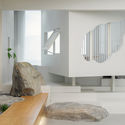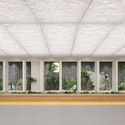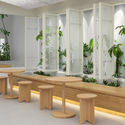
-
Architects: Jiejie studio
- Area: 80 m²
- Year: 2020
-
Photographs:Zhi Xia

Text description provided by the architects. Pushe Tea Room is a tea room project located in an office building beside the third ring road in Beijing. It is surrounded by high-rise buildings and is located in a typical modern block of a big city. "Mental State Dislocation, between Indoor and Outdoor" is the design concept that I want to convey in this project. Through repeated abstraction, switching, and the design techniques of mountain and forest scenes, the dislocation experience of repeatedly switching between the indoor and outdoor of the space could be felt, trying to evoke the perception of being separated from the world by tea drinkers, and then to enrich the spatial experience of the tea room.









































